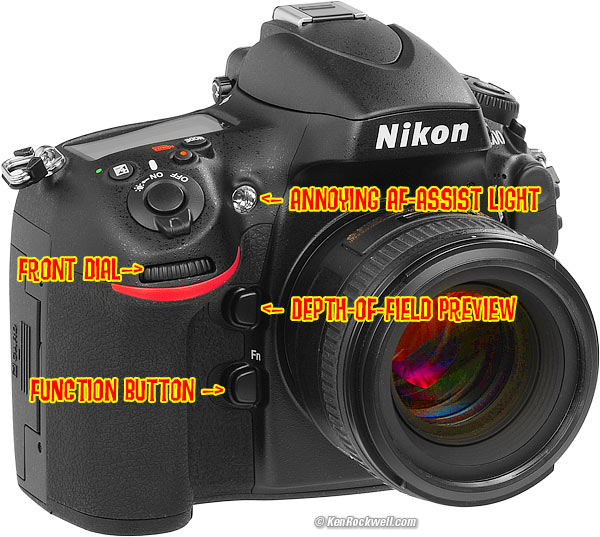Home Donate New Search Gallery Reviews How-To Books Links Workshops About Contact
Nikon
D800 and D800E User's Guide:
Front Controls
© 2012 KenRockwell.com. All rights reserved.

July 2012 D800 and D800E Review Nikon Reviews Nikon Lenses All Reviews
Top of D800 and D800E User's Guide
Help me help you top
I support my growing family through this free website. The biggest help is when you use any of these links when you get anything, regardless of the country in which you live.
If you find this page as helpful as a book you might have had to buy or a workshop you may have had to take, feel free to help me continue helping everyone.
While free to read online, this page is formally registered and copyrighted, so it is unlawful to make copies, especially in the form of printouts for personal use or saving these pages or files. If you wish to make a printout for personal use, you are granted one-time permission to print from your browser (there is no PDF) only if you PayPal me $5.00 per printout, file save, or part thereof, unless of course you bought your D800 through one of my links. This is how I justify spending weeks away from my family writing and sharing all this for free online.
Thank you and thanks for your support!
Front, Nikon D800 and D800E.
Want free live phone support? In the USA, call (800) NIKON-UX, 24 hours a day, 365 days a year.
AF Assist Light top
Lights up only in the dark to help focus.
It's very annoying if photographing people.
You can force it off in CUSTOM SETTING MENU a8.
Front Dial top
Used for all sorts of settings. You knew that.
It usually changes the aperture setting while shooting.
Depth-of-Field Preview Button top
The preview button lies naturally under your middle finger.
Tap this to stop the diaphragm down to the taking aperture. The viewfinder gets darker, but look carefully and you can see what's in focus or not. This is a legacy feature from 35mm days. Today most people look at the LCD playback to see exactly what's in focus or not.
You can program this button do other things as explained in the Custom Function Menu or in the INFO screen.
FUNCTION Button top
The Function (Fn) button lies naturally under your ring finger.
I program this trick button for many different things depending on what I'm doing.
I usually set it to allow instant cropping and digital zoom.
This button is programmed in the Custom Function Menu or in the INFO screen.
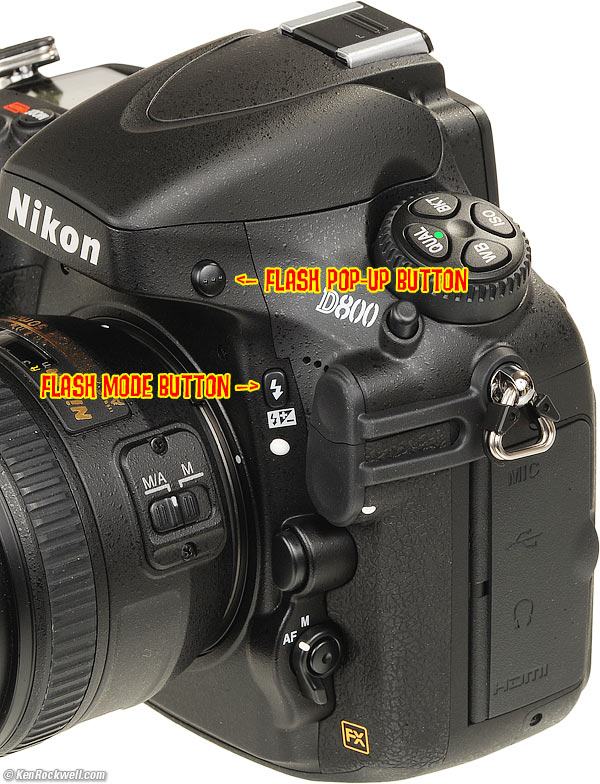
Flash Controls, Nikon D800 and D800E.
Flash Pop-Up Button top
This is an unmarked bumpy black button on the top right of the viewfinder as seen from the front.
Press it to pop up the flash.
Push the flash down when done, and it will lock.
Flash MODE (Bolt +/-) Button top
This is on the right side of the flash hump as seen from the front. This sets the flash sync mode and the brightness of the flash. Flash brightness is more formally called "flash exposure compensation."
Flash Brightness
I never use this. I leave it at zero, and use the regular Exposure Compensation (Lighten/Darken) control instead.
To use this, press and hold the flash mode button and turn the front dial to change the flash exposure compensation. This sets the brightness of the flash, either built-in or mounted on the hot shoe.
+ makes the flash brighter, - makes it dimmer.
Set it to - if your subjects are getting washed out.
Set it to + if the flash is too dark, but if you're beyond the flash's range (about 20 feet) and the bolt in the viewfinder flashes wildly for a few seconds after each shot, you're using 100% of the flash's power, so setting it to + can't make the flash any brighter beyond that.
This setting only changes the brightness of the flash. It leaves the background (ambient) exposure alone.
If you set flash exposure compensation to anything other than zero, you'll see a little "+/- bolt" icon in the finder, on the top LCD and on the INFO screen.
Flash Sync Modes top
Press and hold the flash mode button and turn the rear dial to change the flash sync mode. You'll see the mode shown on the top LCD in the box with the bolt.
Select these by holding down the flash mode button on the side of the flash hump and spinning the rear dial. Your selection is shown on the top LCD in the box with the bolt, as well as on the INFO screen.
Normal (blank icon)
This is the default position.
In Program and A exposure modes, the shutter won't stay open longer than about 1/60 second, which means no blurring, but that the backgrounds usually get dark indoors.
You can change this 1/60 minimum speed in Custom Setting Menu option e2, which defaults to 1/60 second. I have mine set to 1/8. Set a longer time, like 1/8, to allow more ambient light in the photo and prevent inky black backgrounds. Set it shorter to prevent subject motion blur.
This is brilliant! In the old days we'd have to use Manual exposure to set this to a reasonable number like 1/8. The problem with using the slow mode, explained below, is that in dark locations the shutter may stay open a stupidly long time and ruin the shot. This Custom Setting lets you have the camera adjust itself automatically and stop at the longest time with which you feel comfortable.
I usually use Normal mode, since if I don't I can get some scary long exposures if I'm not expecting them in the dark.
Since I use AUTO ISO, AUTO ISO usually ramps-up the ISO with flash as well, doing an even better job of getting flash and ambient light to balance.
Red-Eye (eyeball icon)
I never use this. It shines an obnoxious light in your subject's eyes for a couple of seconds and then releases the shutter only after you've already missed the picture. Use this only if you have some people you want to get rid of at a party.
Warning: If I set the Red Eye mode by accident it bugs the heck out of me, because the camera doesn't go off until several seconds after I've pressed the shutter, but I've set no self timer! It doesn't do much to reduce redeye anyway. Skip this mode. You won't know you've set it, since there is no in-camera indication. If for some reason the shutter seems to have a weird delay, check this!
SLOW
This mode lets the shutter stay open as long as it needs to so dim ambient light can expose properly with flash. These exposure times can get stupid long, in which case you want to use the setting I covered above under Normal.
In daylight, SLOW is the same as NORMAL, since exposure times are short. SLOW unlocks the camera in P and A exposure modes to make exposures as long as it wants to in dim light.
Have a look at most issues of National Geographic and you'll see many indoor shots made in this mode. The background exposes correctly, people may be blurred, and a burst of flash freezes them along with the blurry ghost images.
Normal and SLOW do the same thing in S and M exposure modes, since you or the camera may select any shutter speed in these modes regardless of flash sync.
Red-Eye SLOW
This is the SLOW mode and redeye combined. I don't use it for the same reason I don't use the Redeye mode.
REAR
When you're shooting with flash and long exposures, this makes the blur appear to come from behind moving subjects.
Normally the flash goes off the instant the shutter opens. This makes sense, but looks stupid if you have motion blur because the blurs will be in front of the moving subject, making it appear to be going backwards. Select REAR mode to have the flash go off as the shutter closes so that the motion blur will make your subject appear to be going forwards.
Another reason to select REAR is because people presume photos are made the instant a flash fires, then they leave or blink. This wreaks havoc with long exposures, since people will leave at the beginning of the exposure! Use the REAR mode and the flash doesn't go off until the end of the exposure. You'll also want to select flash exposure lock to eliminate the preflash. Read about programming the FUNC button to do that here.
REAR doesn't do anything with short exposures. REAR also engages SLOW, but SLOW doesn't light up on the LCD until you take your finger off the flash mode button.
Studio Flash Sync Connector top
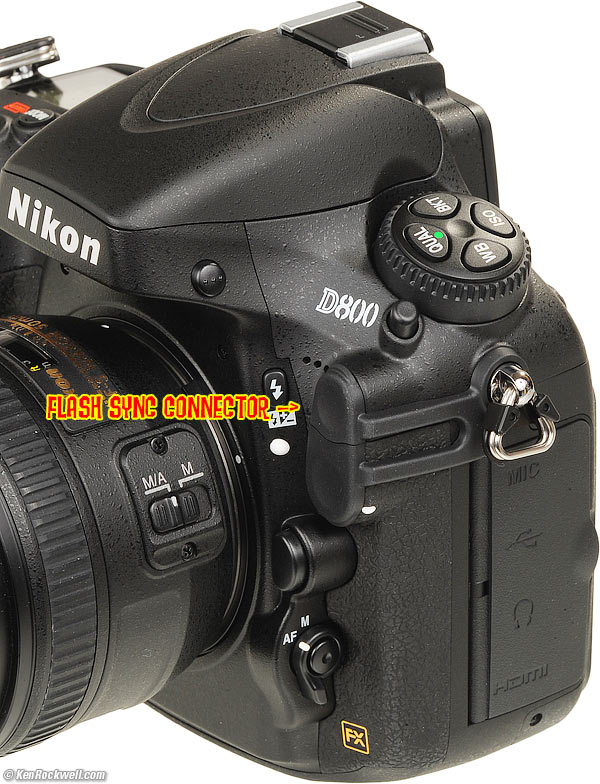
Flash Sync Connector, Nikon D800 and D800E.
Pop open the tethered rubber cover to connect a PC cord from your professional flash system to your D800 and D800E.
PC stands for Prontor Compur, a popular German shutter back in the 1930s who invented this connector. The PC connector has nothing to do with personal computers.
Remote Terminal Connector top

Flash Sync Connector, Nikon D800 and D800E.
Pop open the tethered rubber cover to connect one of Nikon's expensive electronic remote controls, like the $57 MC-30 and $125 MC-36.
Since Nikon overprices these, you can buy counterfeits cheap, but honestly, the release you buy today will last you far longer than any digital camera. I still use the one I bought back in the 1990s before the practical DSLR was even invented. These work on just about all motorized Nikon film and digital cameras.
Sorry, but the D800 and D800E won't work with the superb pocket-sized $15 ML-L3 wireless cable release, as the cheaper cameras can. Since Nikon knows you're a big spender with the D800 and D800E, you'll have to buy the clumsy $200 ML-3 wireless release system instead to do the same thing!
Nikon doesn't bother to thread the shutter release, so you have to buy one of these gizmos instead of a standard $9 cable release.
Lens Release top
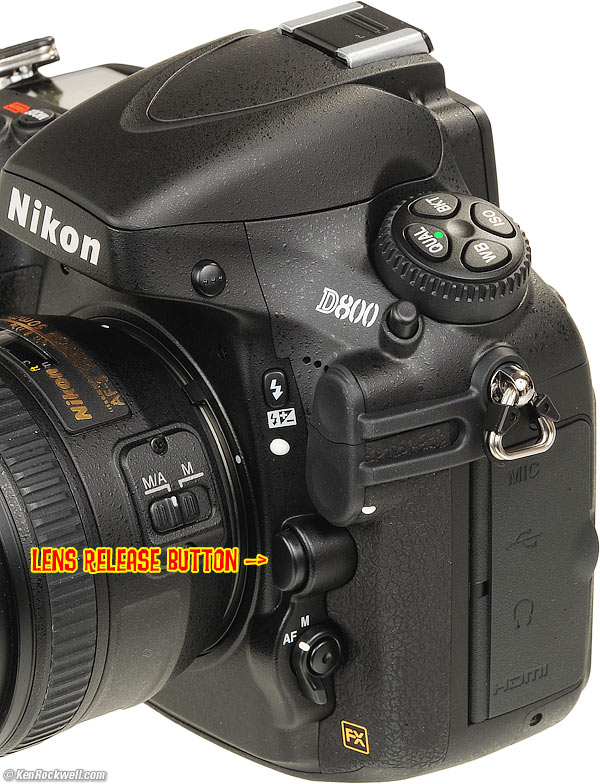
Nikon D800 and D800E lens release button.
Push this button and turn the lens to remove it.
It locks automatically when you attach and rotate a lens.
Focus Mode Switches top
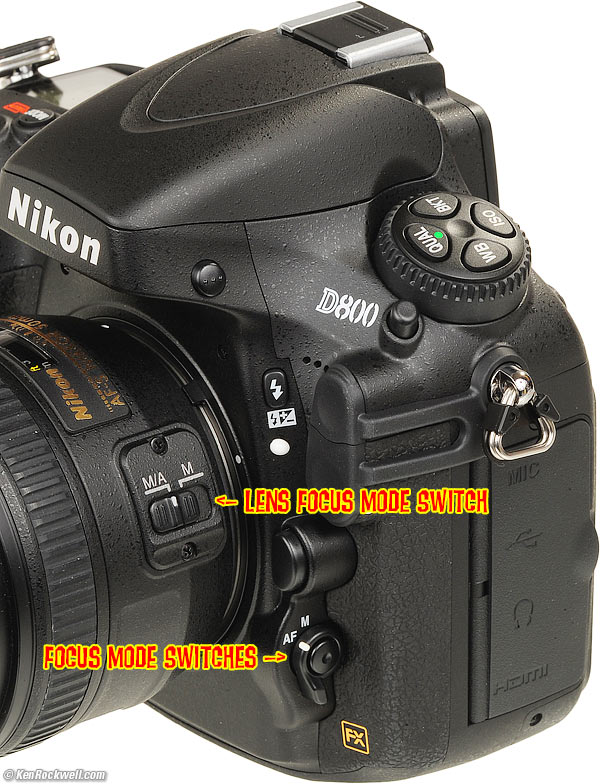
Nikon D800 and D800E focus mode switches.
See my Guide to Setting the D800 and D800E's AF System for using this.
Top of D800 and D800E User's Guide
AUTOFOCUS
Setting the D800 and D800E's Autofocus System
KNOBS and BUTTONS
TOP PANEL < < NEXT
MENUS
Home Donate New Search Gallery Reviews How-To Books Links Workshops About Contact
